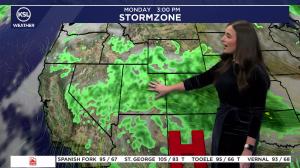Estimated read time: 4-5 minutes
This archived news story is available only for your personal, non-commercial use. Information in the story may be outdated or superseded by additional information. Reading or replaying the story in its archived form does not constitute a republication of the story.
STOCKTON, Tooele County — Renee Williams grew up around Dugway and the secret atmosphere of military testing in the remote sagebrush country of Tooele County.
So, naturally, she was delighted 27 years ago when she landed a civilian job at Tooele Army Depot and went on to become among the first women to handle highly dangerous chemical weapons in the field.
"I loved my job, even when it was back so secret," she said. "I loved the work, loved handling the munitions and loved what we were doing — making the county, the country, a safer place."
A contract employee of the U.S. Department of Defense who now works as an administrative specialist, Williams is watching twilight settle over the mission of the Tooele Chemical Agent Disposal Facility — once home to the nation's largest chemical weapons stockpile. On Wednesday, officials marked the near-end of the disposal process, rendering useless the last of the 155-milimeter projectiles packed with mustard agent.
A metals furnace that heats up to 1,500 degrees Farenheit burned off any of the residual poisonous chemical that remained on a tray of 23 projectiles that were later covered with a protective blanket to prevent the escape of any dangerous emissions. That burning and subsequent cooling process was witnessed on site not far away from the actual operation, but through the safety of remote video linkup.
The end of those last traces of chemical agents this weekend marks the conclusion of a 16-year, $3 billion mission in Utah. It will mean seven of nine U.S. sites of stockpiles of chemical weapons are destroyed.
On Tuesday, the last two, two-ton containers of the agent Lewisite were taken to what's called the Area 10 Liquid Incinerator. When that several-day process concludes — some time Saturday — spokeswoman Alane Grieser said all the original stockpile will effectively be destroyed, even the residual traces.
Williams retired in 2005 and then came back as a contract employee. She spent a dozen years in full protective gear working in the earthen igloos handling the weapons, inspecting them for problems.
"I had to make sure they were not leaking. They had to be ready if the U.S. ever called for them, which they never did."
The time came when the weight of the gear and the health of her joints necessitated taking a desk job, but she looks back fondly on her part in helping to destroy one of the greatest military threats to mankind.
"We were proud to be part of that."
The end of those last traces of chemical agents this weekend marks the conclusion of a 16-year, $3 billion mission in Utah. It will mean seven of nine U.S. sites of stockpiles of chemical weapons are destroyed, with only 10 percent remaining of what the country declared — 31,500 tons — back in 1985.
Tooele was the first continental site in the United States to go operational in August 1996. Since that time, 1.1 million munitions have safely been destroyed.
Col. Mark Pomeroy, depot commander, called this events of the past few days part of an "incredibly historic week," and said it respresents the "resolve of a nation to destroy these terrible weapons."
- 798,703 GB 155mm projectiles
- 5,709 GB ton containers
- 4,463 GB MC-1 bombs
- 30,001 GB M55 rockets and M56 rocket warheads
- 89,142 GB 155mm projectiles
- 888 GB Wetey bombs
- 7,822 VX M55 rockets and M56 rocket warheads
- 632 VX ton containers
- 53,216 VX 155mm projectiles
- 862 VX spray tanks
- 22,690 VX landmines
- 54,453 H 155mm projectiles
- 62,274 mustard 4.2 inch mortars
- 6,399 Mustard ton containers
- 4 GA ton containers (only U.S. stockpile; captured from Nazis following WWII)
- 10 Lewisite ton containers (only U.S. stockpile)
With the last of Tooele's stockpile of 13,617 tons destroyed, the agency will be declared to have met its obligations of the Chemical Weapons Convention Treaty. That accomplishment means the facililty has destroyed more nerve and blister agents than practically any of the other U.S. missions combined — some 43 percent of the country's stockpile.
Greg Mayhall, spokesman for the U.S. Army's Chemical Materials Agency, said international inspectors who have been on site at Tooele since the inception of its mission will verify that all agents have gone to a "non-detect" status.
"They are the independent verifiers of the process that has been going on," he said. "Once they double check and verify that it is gone, that is when you have achieved treaty status. They'll start heading home to their host countries."
As of Wednesday, 27,468 U.S. tons of the chemical agent have been destroyed, with the rest awaiting destruction at two facilities under construction in Pueblo, Colo., and Bluegrass, Ky.
It is expected that of those military and civilian employees who don't retire or find other jobs at the Tooele Army Depot or at Dugway will head to Colorado or Bluegrass, Ky., because of the highly specialized nature of their work.
About 1,100 contract employees remain and a couple hundred military workers.
Last week, the first official reduction in force happened, with 52 workers impacted.
Actual "closure" of the facility southeast of Tooele won't happen until probably fall 2014. By then, the Tooele Army Depot will have taken over the reigns and the area will become the new Tooele Army Depot "South" for storage of conventional munitions.
Buildings with any hint of contamination will be just a memory — demolished — and the goal, according to Army Project Manager Ted Ryba, is to leave it all "green grass and daisies."
"I am proud to have been here and to be part of this from the very beginning. It gives me great joy and satisfaction in being done," Ryba said. "But it is a bittersweet experience to see the fruits of your labor have to be torn down and finding something else to do."
----
Written by Amy Joi O'Donoghue with contributions from Jed Boal.








